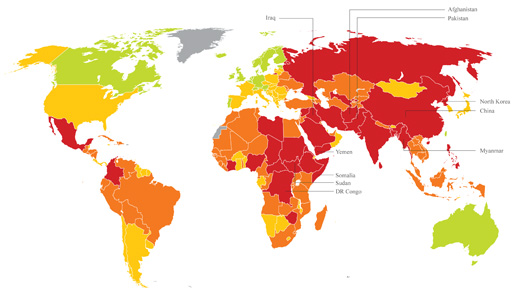As this map indicates, while we speak of human rights as universal (as defined in the Universal Declaration of Human Rights of 1948) we are not all at equal risk for having our human rights violated.
Human Rights Risk Index Map 2012
From Maplecroft:
An annual Human Rights Risk Atlas, analysing the extent of human rights abuses in 197countries, has revealed that human rights and labour standards risks for companies and investors are increasing on a global scale, with 48% of the world now posing ‘extreme’ or ‘high’ risks of corporate complicity in rights violations.
According to risk analysis and mapping company Maplecroft, author of the fifth annual Human Rights Risk Atlas (HRRA), citizens in 95 countries are now exposed to human rights violations by states. This represents a 6% increase in countries posing ‘extreme’ or ‘high’ risks, to business and investors since 2010.
Maplecroft states that the global increase in human rights risk is attributed, in part, to three main factors. First the violent crackdown on protesters by security forces during the Arab Spring uprisings, which were sparked by anti-government sentiments relating to corruption, oppression of rights and rising food prices. Secondly, an emerging set of resource scarcity challenges for business, linked to large scale ‘land grabs’ in developing countries by foreign investors, aimed at increasing food, water and energy security at home, including biofuels production. In addition the global economic recession continued to challenge the rights of workers, with the results of the HRRA revealing a trend for the trafficking of migrant workers for forced labour i n countries such as Malaysia, Russia, South Africa and UAE.
The HRRA 2012 has been developed by Maplecroft to enable organisations to evaluate and monitor the risks and responsibilities of investing in countries and companies in terms of their human rights risk exposures in their global operations, investments or supply chains. It analyses 23 types of human rights violation within the categories of human security, labour rights, civil and political rights and access to remedy.
I highly recommend taking a look at the map – which also examines “corporate complicity in rights violations.”




